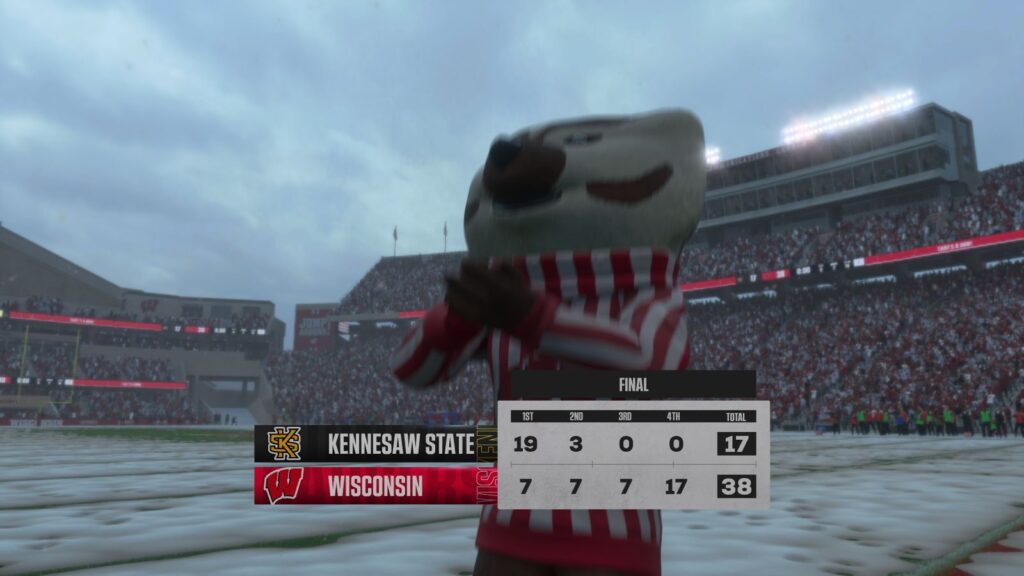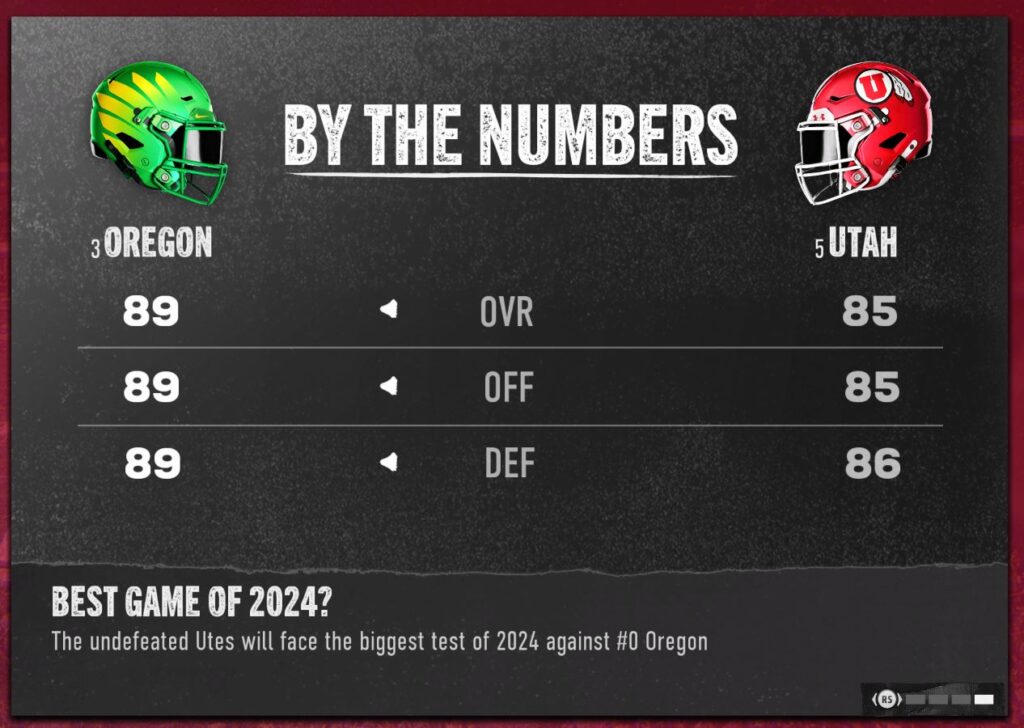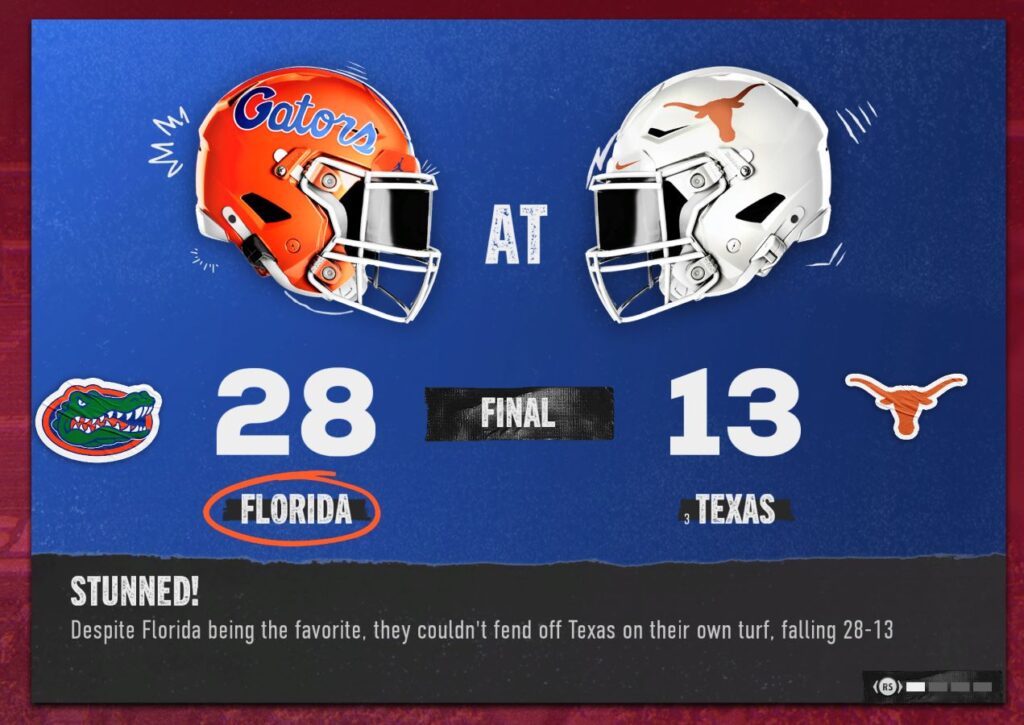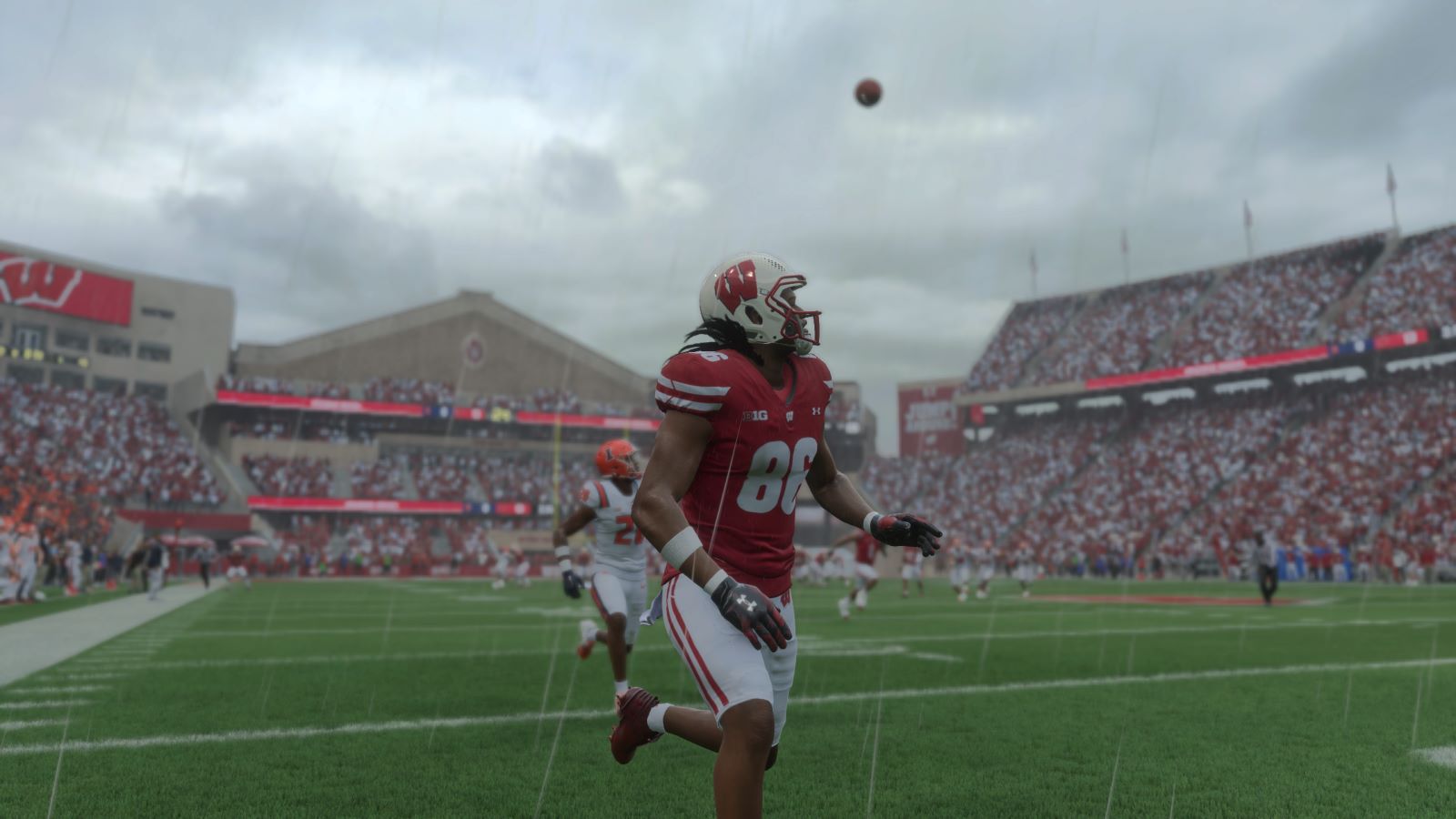After more than a decade, the latest iteration of EA Sports’ College Football series has been released. College Football 25 has been available worldwide since July 19 and it’s time to add another first impressions review to the thousands already made. A finalized review of College Football 25 will be posted early in 2025 to account for any changes made by EA and its development team. This review will be broken down into three sections: The Good, The Bad, and The Ugly with all three heavily subjective to my personal experience. Without further ado, let’s show some gameplay before getting started on the good aspects of the game (so far).
The Good
The obvious starting point for the good section: the graphics are impressive. The lighting in the game makes it feel as if you are watching the game live and does an excellent job of immersing the player in the game. There’s an authentic feel to playing CFB 25 that is clearly a step up from the previous titles in the series. The combination of high-end graphics and next-generation consoles is a big boon to how the game feels (sorry PC folks). Below is a clip from my first dynasty game against Colorado that illustrates how good the graphics look.
Given how impressive the graphics are, it is also amazing that the game doesn’t take up as much space on a console compared to other popular titles. The launch of EA CFB 25 was less than 30 gigabytes and the subsequent first week update was 1 GB for PlayStation and 8 GB for Xbox. Part of the reason for the relatively small file size is that the entire game was rebuilt so years of code aren’t causing the game to be bloated. While this is a positive now, it will be worth following through the years to see if the bloat becomes real.
Some of the features within the Dynasty and Road to Glory modes are great. For Dynasty, customizable conferences are back with the option to turn on or off divisions, set the number of conference games, and determine whether there should be a conference title game. You can undo the last few years of realignment chaos if you so choose. Teambuilder is also available in the online Dynasty mode, which gives more depth to the game and brings back some nostalgic memories of creating a program and building it to compete against the best in college football.
For Road to Glory, the older EA titles had the player start in high school and then build up a profile towards National Signing Day. In CFB 25, the player chooses which archetype (Elite, Blue Chip, Contributor, or Underdog) they want with varying levels of rewards. For example, the “Underdog” archetype will have to grind their way to a starting spot. After you create your player and choose your archetype, you immediately select which school you want to sign with while considering the starting point (bench player, second string, or starter). One of the positive aspects of the Road to Glory mode is the inclusion of the minigames as a way to help train and improve your created player. This allows the user to work on a specific drill they want to master or simply look for a challenge.
Speaking of those minigames, they are reminiscent of older Madden games that had the “training camp” mode. The minigames can be played as a standalone mode and cover all aspects of the game: offense, defense, and special teams. The developers even put in some different game modes within the minigames as a fun challenge to complete. Players have to reach a certain score to achieve either a gold, silver, or bronze. There is a lot of repeatability with the minigames and is a welcome addition.
The Bad
There are quite a few minor issues with the gameplay so we started a YouTube channel to document as much as we could. It’s not all bad gameplay and there are (or will be) some examples of good things about the game such as excellent timed and animated tackles. Below is one example of the football levitating on its own during a cutscene in the Road to Glory mode.
Specifically for Road to Glory, choosing the underdog archetype was a long grind and was boring at points. I chose to be a power halfback and enrolled at the Air Force Academy because the school’s focus on the option style offense suits that role. Or so I thought…
For the first two years, I completed the training and weekly agenda with almost no game action, which meant the entire game simmed without me playing a down (I ended up getting maybe a dozen plays as a sophomore after zero as a freshman). By my junior season, I finally was able to get some position battles and reach the starting position… except the actual gameplay didn’t match the position role. I ran the ball about 20 times in my junior season because the game decided the fullback dive was the best choice 98% of the time. I was the team’s leading receiver playing as a wing-back and that’s only because you can call for a pass but my preferred role was power halfback.
After my junior season, I decided to enter the NFL Draft just to get the experience over with. The option to transfer was available but other schools had me as a backup or third string due to a lower overall rating, which is a downside of choosing the underdog archetype. Overall, Road to Glory wasn’t satisfying as a running back in the underdog role but that may change in the future as other options and positions are tested.
Some minor issues experienced were with Teambuilder including the website not working, not being able to include certain special characters like the ampersand (&), and a limited selection of generic playbooks not associated with a school. This wasn’t unexpected with everyone wanting to create their own school but given the popularity of the game, it should have been easily anticipated by EA. Probably the biggest personal sticking point is the inability to use Teambuilder programs in offline Dynasty mode, which was available in older versions of NCAA Football. While annoying on a personal level, it’s a minor gripe compared to others that will be discussed in the Ugly section.
Another area of improvement for CFB 25 is bringing back the fight songs when navigating between games. The drumline beats are repetitive after a while and would be better if they were interspersed between fight songs. There are no lighting transitions for shadows changing during afternoon games, there’s no trophy room, and no ability to see stats from previous years in Dynasty mode. The latter two were in previous titles and provided a nice way to see how previous seasons ended.
Commentator voices can be low or drowned out by the crowd noise, especially when David Pollack is talking. Voice lines get repetitive quickly, especially if there’s a blowout and there will be some derivation of “the game is starting to get out of control” repeated after every touchdown as if there’s no continuity between lines. The voice lines also seem out of place and unnatural, which isn’t surprising given the prerecorded nature but they don’t flow as well as previous NCAA Football titles.
The Ugly
The lack of training guides, videos, or documentation for the different features in the game is inexcusable for a project that was delayed a year. Reading social media posts about how to use some of the newest features is not ideal when it should be incorporated into the game. In recruiting, there’s a chance the prospect will either be a green diamond (a gem with a higher ceiling) or a red diamond (a bust with a lower ceiling). There was no mention of that within the game and it required a Google search to understand its implications. There are other aspects like the dots over a player’s head and playmaker abilities that I still don’t fully understand.
Another awful aspect of this game is the AI logic, simulation logic, and a graphical glitch that is nearly game-breaking. There’s a very noticeable spike in CPU scoring at the end of halves and it’s horrendous in a close game in the 4th quarter because the opposing defense will start pick-sixing everything. This is something we discussed in our Hopes for the Next EA College Football Video Game article from March 2024. We said, “There’s nothing wrong with a challenge but when the AI starts intercepting every pass, it becomes a bit over the top.”
The issues don’t end there for the AI logic. Passes that were caught in the first half magically become drops if they weren’t intercepted and returned for a touchdown. Your offense’s blocking will cease to exist. Most ridiculous is when using the super sim option, the opposing scoring drives are typically 30 seconds or less late in the first and second halves. This kind of rubberbanding makes the game less enjoyable. However, adding in a score bug glitch to that could potentially ruin the game as I experienced.
I was unable to get a video of this but in a game against Michigan, the pause menu showed the Wolverines trailing 24-13 but the score bug during gameplay while playing showed the score as 24-16. Imagine my surprise when Michigan started to make a comeback thanks to the magic of the AI logic and those additional three points became more meaningful. That’s the definition of game-breaking because it nearly cost me the victory. If you want a similar example to the one I experienced, here’s a clip of the glitch caught in 4K.
A smaller but also unacceptable issue is the lack of mass substitutions. There’s nothing worse than having to go to the depth chart and manually replace every single position in a blowout when previous titles had the option to bring in the second team with a few clicks. This is a small but underrated quality-of-life improvement that would make the game feel more polished.
First Impression Rating
While playing this game and thinking about the first impression review, the game was about 7.5. There’s a solid groundwork in terms of graphics and gameplay. More depth in the Dynasty and Road to Glory modes along with training guides or documentation would improve the game overall. There are minor issues that prevent the game from feeling complete but some of these are likely to improve throughout the life cycle or in future versions (hopefully).
However, the near game-breaking AI logic pushes the overall score down. There’s simply no reason for the super sim to drastically favor the opposing team at the end of halves – a phenomenon that occurs at all difficulty levels. The score bug graphic glitch nearly costing a victory is truly inexcusable for a game that saw a year-long development delay. Maybe this is a one-time glitch but the very first game played had the same thing on the final score graphic, albeit not showing on the gameplay score bug.



By no means is EA College Football 25 a bad game but many minor features seem to have been overlooked in favor of the focus on the graphics, gameplay, and authentic traditions of the schools. Some of those features like the wonky super sim/AI logic and lack of mass substitutions do take away from that gameplay. For those reasons, the first impression rating is 7 out of 10 and the hope is the developers can take the proper steps to improve the game over the next few months with the inclusion of more quality-of-life features.
First Impression Rating: 7 out of 10
